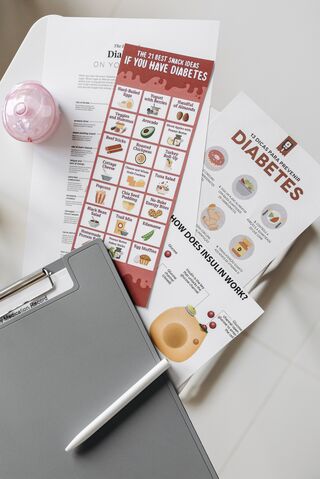Diet
Right-Sizing Works Better than Losing Weight
How to frame weight correction in a way to promote its success.
Posted December 22, 2021 Reviewed by Abigail Fagan
Key points
- Obesity can lead to the development of elevated cholesterol, fatty liver, and type 2 diabetes.
- A correction in weight can promote improvement or resolution of type 2 diabetes.
- Hunger before a meal can be thought of as a good sign that you have eaten an appropriate amount during the previous meal.
How do most of us react when our doctor tells us that we need to lose weight? Typical responses might be, “I know, but it’s too hard. I’ve tried,” or “I should do that in a few years.” And how do we react when we develop a health complication of obesity, such as diabetes, hypertension, or heart disease? “I guess my luck ran out,” or “Doctor, please do something to fix the problem.”
These reactions relating to being overweight have run through my mind at different times. Finally, because of some wisdom that I gained over the years through my work as a pediatrician, the time came when I reacted differently. I learned how to help myself accomplish major weight reduction.
In this post and the one to follow about my right-sizing journey, I describe how I came to the moment of decision to deal with my obesity, and how I framed the beginning of this journey in a way that would help promote its success.
***

My personal physician held a small green leaf between his thumb and index finger. This was the beginning of the odyssey that reshaped my life and taught me a lot about how physicians, family members, and friends might improve their treatment and support of patients.
“Do you know what this is?” My physician of nearly 15 years asked me.
I stared at the leaf, bewildered, because my medical training was not helpful in figuring out which species this plant was from. I looked at my wife who was sitting next to me because I wanted her to hear what my physician had to say about my health. She shrugged.
“This is a new leaf,” he announced, while flipping it. “It’s time for you to turn over a new leaf.” This demonstration by my physician was different enough that I paid closer attention than usual. Further, using the leaf as a symbol may have spoken to a different part of my mind than did words. Perhaps, this was one of the reasons for the effectiveness of our interactions that day.
I understood what my physician was talking about. My fasting blood sugar and hemoglobin A1C, which are measures of sugar control, recently were documented as elevated.
“You have type 2 diabetes,” he explained. “In the old days we would tell you to go lose weight, and when you had your first heart attack 10 years later we would begin treatment. But now we can take care of you immediately with medications.”
I knew that my weight was an issue, and my cholesterol had been high for over 20 years. My physician had told me that I had familial hypercholesterolemia because my mother and maternal grandmother also had high cholesterol. I reacted to that information by consoling myself that there was no history of heart disease in my family. I had a similar reaction when I was told that the mild elevation of my liver enzymes was a result of a fatty liver, which leads to the development of liver failure in 20% of patients. I reassured myself that since I did not drink alcohol, which predisposes to the development of fatty liver, I did not have the same risk factors for liver disease as other patients.
My physician was drawing a graph and explained, “At some point, insulin production in the pancreas is insufficient to keep up with the body’s requirements and the blood sugar begins to rise. Now, if you lose a significant amount of weight, then your diabetes would resolve. We can give you an oral hypoglycemic and I’ll probably prescribe injections as well.”
Wait a minute, I thought. If weight loss can resolve my condition, why would I want to take any medication? And I certainly did not want daily injections. So, I decided on the spot, if weight loss will solve my problem, then I will lose weight.

My wife asked what was healthy for me to eat. My physician handed her a colorful booklet that she examined. “This only talks about the caloric content of fast foods and brand name products. I like to prepare food for my family. What are good foods?”
He paused, and then replied, “I don’t have any written information about that. The current basic idea regarding diet is portion control. Limit the total amount of caloric intake, no matter the source, and you will achieve weight loss.” Both my wife and I had the same thought. If diet control was so important, why wasn’t literature available for us regarding how to effect a significant change in diet?
The Right-Sizing Plan
My wife and I went to have lunch after the appointment. We shared a vegetarian wrap, an unusually small lunch for us, and which I learned later was not the best food choice.
“This is a real opportunity for us!” I told my wife. “My body is saying that I can no longer continue to eat the way I have been. We can take this opportunity to both adjust our diets, which will help us be healthier,” I explained. My wife acknowledged that she too could benefit from weight reduction. “So, this is very good news for our family,” I concluded.
As part of my practice as a pediatrician, I instruct patients in self-hypnosis techniques as a way of helping themselves accomplish their goals. Through this work, I have learned about the power of words and suggestions, which I decided to employ to help myself.
Thus, rather than engaging in an effort to lose weight, I decided to “right-size.” I chose to keep my focus on the positive: to imagine how I would appear once the right-sizing took place, rather than think about the weight I was losing. Who wants to lose anything?
Very quickly I learned that by restricting our caloric intake, my wife and I became hungrier. I figured out that the helpful response was to make hunger my friend during this journey rather than something to be avoided. Hunger before a meal meant that I had eaten a reasonable amount during the previous meal to help me achieve the right size. I decided that since hunger starts with the letter “h,” whenever I felt it, I told myself I was “happy” or “healthy.” Many times, my wife and I would discuss how happy we were. Sometimes, very, very happy. Thus, hunger was reframed from a negative to a positive self-suggestion regarding this beneficial sensation.

I became convinced that right-sizing would be very manageable when I learned that in order to become 50 pounds lighter within a year I would need to exercise for 30 minutes a day and cut back on my daily intake by 300 calories (kcal), which is the equivalent of about one hamburger. (One pound of weight can be lost in a month as a result of eating 120 kcal less a day, which is the equivalent of a thick slice of bread.)
In the second part of this series, I will discuss the results and lessons I learned from the right-sizing experience.
Portions of this blog were also published by the Syracuse Post-Standard.




